





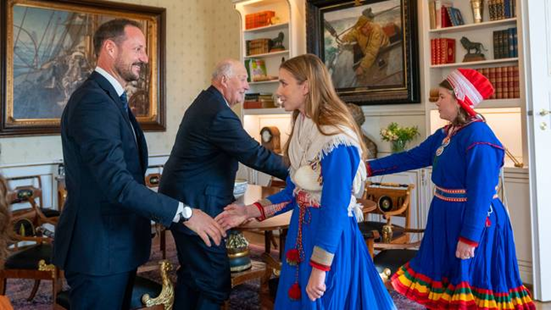
On the wall in our summerhouse, I have a model of one of my favorite ships, Restauration, a sloop built in 1801 in Hardanger, Norway. Restauration set sail from Stavanger on July 4, 1825, with 52 people aboard, a small religious group who were followers of lay preacher Hans Nielsen Hauge. Known as the Haugeans (“Haugianere”), the group was searching for religious freedom and better economic opportunities. The Restauration holds a special place in Norwegian American history, and this year we celebrate the 200-year anniversary of that first emigration from Norway to the United States of America.
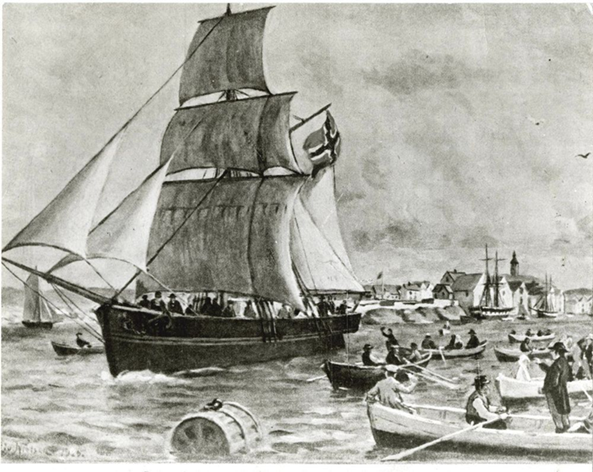
The Haugeans faced persecution in Norway due to strict laws limiting religious gatherings outside the state church. Inspired by the promise of greater freedom in America, the group organized their departure with Cleng Peerson, known as the father of Norwegian immigration, playing a pivotal role in scouting opportunities in the United States of America.
Restauration was a small, single-masted sloop originally built for coastal trade. It was refitted for the journey; but, only fifty-four feet long, it was far from ideal for an ocean crossing. With 52 passengers aboard, far more than its legal capacity, the ship was overcrowded, and the journey was challenging, with limited space, food, and harsh conditions during the crossing. After a journey of 14 weeks, Restauration arrived in New York City on October 9, 1825. Upon arrival, the Captain, Lars Olsen, was arrested for violating U.S. immigration laws by exceeding the vessel’s passenger limit. President John Quincy Adams later pardoned him, recognizing the group's pursuit of freedom.
The group, who came to be known as “Sloopers,” initially settled in Kendall, New York, near Lake Ontario, where they began farming. Their arrival marked the beginning of Norwegian immigration to the U.S., which would grow significantly in the 19th century. In the decades that followed, thousands of Norwegians, primarily farmers, settled in the Midwest, particularly in states like North Dakota, Minnesota, Wisconsin, and Iowa, drawn by the availability of fertile land. Over 800,000 Norwegians immigrated to the USA. In terms of population, only Ireland had more emigrants to America than Norway.
I look at the model on my wall and can hardly believe they made it over the Atlantic. I close my eyes and can see the difficulty of daily life onboard when the rain and the wind made their days almost unbearable and was aggravated by a limited supply of food and water. The voyage of Restauration symbolizes the spirit of adventure, faith, and resilience that characterized Norwegian emigrants. This event gives us insight into an important episode of Norwegian history. Norway has not always been one of the richest countries in the world. The fact is that 40% of the Norwegian population found life so unbearable that they sold everything they owned and set sail towards a new horizon.
By 1920, Norwegian American communities were well-established, contributing significantly to the cultural and economic development of the region. Today we believe that more than five million Americans will call themselves Norwegians or descendants of Norwegians. I have been lucky to meet many of them at the yearly event in Minot, North Dakota called the “Hostfest,” (Fall Festival) but also at many other events around the country. The voyage is celebrated as a pivotal moment in Norwegian American history, with October 9 recognized as Leif Erikson Day in the United States to honor Norwegian contributions to American culture.
As a result of an idea and a dream carried forward by local enthusiasts with a genuine interest in history and boat building, a foundation was established in 2007 with the purpose of reconstructing Restauration, one of Norway’s most famous sailing vessels -- a ship that is nearly identical to the original, based on traditional boat building tradition. The replica of Restauration was built by Ryfylke Trebåtbyggjeri on Finnøy and launched in 2010.
This summer, the replica of the ship will travel exactly the same route as the original ship. In an interview with the Norwegian newspaper VG, the new Norwegian Ambassador to the United States, Anniken Huitfeldt, noted that the 200th anniversary of the beginning of Norwegian emigration to the United States will be celebrated through the entire year of 2025 and will be an important event to strengthen the strong relationship between the United States and Norway. The King and Queen of Norway will participate in the historic departure of the Restauration from Stavanger on July 4, 2025.
The official website for the 2025 commemoration, "Crossings" offers information on events, historical insights, and educational materials related to the bicentennial. These celebrations aim to deepen the understanding of Norwegian American heritage and the historical significance of migration, fostering appreciation for the shared history and cultural contributions that have shaped both societies over the past two centuries.
Website: https://restauration.no/en/crossings-200-eng/
Vesterheim, the National Norwegian American Museum and Folk Art School in Decorah, Iowa, will host a special exhibition titled "200 Years of Norwegians in America" from December 6, 2024, to January 31, 2026. This exhibition will showcase significant objects, photographs, and stories from two centuries of Norwegian American history. In Northfield, Minnesota, St. Olaf College's Norwegian Department has initiated "25 for 2025," featuring 25 events and programs to engage with the bicentennial, including lectures, workshops, and cultural exchanges. Finally, The Norwegian Honorary Consulate General in Minneapolis is coordinating various events across North America and Norway to commemorate this milestone, providing platforms for reflection on migration and its impact on both nations.
I hope to be in Stavanger on July 4th and in New York for the replica’s arrival on October 9th this year. Perhaps you can attend some of the many events that will celebrate our history this coming year. I will use my ship’s model to remind me of all the brave men and women going ahead of us. I had Hope as my theme last year and have selected Celebration as my theme for 2025, and I will share information with you each month that is worth celebrating.



